Making Sense of the Travel Learning Experience - 2
This is Part 2 of a 3-Part presentation.

Although dated and working with only didactic communication (ie that which is largely one-way as in a lecture), these simple questions still act as a useful way of performing a quick analysis. Harold Lasswell was a political scientist. His five questions have been described by McQuail and Windahl (1993:10) as “perhaps the most famous single phrase in communication research”. Richard Braddock added two more and the resulting set when applied to tourism communication opens up a much clearer appreciation of what promoters and interpreters are saying. Try applying it to a tour operator’s brochure, a guidebook, visitor centre exhibition or the words of a member of staff on an information desk. What about that imposing building admired by tourists? All kinds of illuminating ideas begin to come to mind.
McQuail, Denis and Windahl, Sven (1993) Communication Models for the Study of Mass Communications, Harlow, Longman
This next section also draws on the very detailed work by Rogers, Everett M (1997) A History of Communication Study, New York, The Free Press

Claude E Shannon and Warren Weaver developed a version of Lasswell’s ‘one-way’ model. They worked for the Bell Telephone Laboratory so it used the terms ‘information source’, ‘transmitter’, ‘signal’, ‘receiver’ and ‘destination’. It also used the term ‘noise’ to describe anything that interfered with the ability of the signal to be delivered accurately. For Bell engineers this meant electronic interference. As Shannon developed what he called ‘information theory’ the word took on new meaning – any competing phenomenon, whether it was aural, visual or other sensory interference.
Using Shannon & Weaver as a basis, Melvin L DeFleur confirmed the idea of a thought by source (eg a person) A as being converted into a message, encoded and transmitted through a channel to receiver B; decoded and passed to the destination (eg a second person. Noise could interfere with every stage. Shannon & Weaver had considered only interference in the channel. The thought passed through to B should be identical to that sent by A. DeFleur added the lower sequence to represent B’s reply. If A then perceived that B shared the exact thought, the comunication was successful. DeFleur said that perfection was seldom achieved.
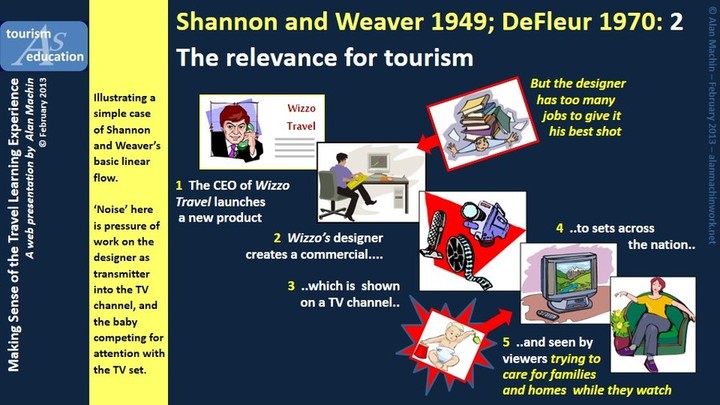
Taking the top sequence from the previous slide and using it as the basis for a typical tourism activity leads to a familiar marketing situation. In this example the main communication channel is that of a television commercial. The effect of two sources of noise suggest a little of the range that Shannon and Weaver identified. The baby distracting the TV viewer does so by producing actual noise – though the sight of the baby is probably more basic, though less insistent, on drawing attention away from the TV set. The ‘noise’ affecting the designer might be visual – an overflowing in-tray – or aural, as the boss piles on pressure and the phone rings.
But it is obviously a simplification from a real situation. More people and more influences abound. A later slide (#16) will hint at a more complex situation involving a museum display. The chain of communication channels and people stretches further in every case. What counts is the usefulness of theories like those of Shannon, Weaver, DeFleur and others in helping us to understand the communication processes at work.
Melvin DeFleur moved the discussion on to the importance of feedback, as the next slide illustrates.

The observed effects of an action help us to see if it needs to be repeated more accurately. Tutors ‘give feedback’ so their students can improve their work. The term came from broadcasting in the 1920s. If a microphone was set at too high a level of sensitivity it fed unwanted sounds into a broadcast and they came out distorting what listeners were hearing. Each sound picked up by a microphone was feeding in. Hearing it loudly distorted was said to be feeding back. Action needed taking to set the mike more accurately.
During the Second World War, work to make the aiming of anti-aircraft better led to the formulation of theories in cybernetics, the “system of control and communication in animals and machines” according Norbert Wiener who is regarded as one of its main originators.
The word has now become widespread and popular. It has also gained different usages. Heath & Bryant (2000) write:
“Perhaps no other term is used more loosely and imprecisely when referring to the communication process ... We use the term incorrectly when we say, ’Give me some feedback.’ Whatever the person says or does at that point can be used as feedback, but it is not feedback“.
“Feedback is the interpretation of information they receive that helps them to determine whether their strategies are accomplishing their goals. ... feedback is defined as information a person (or machine) receives and interprets that allows him or her to determine whether his or her action (such as message) had the desired effect to achieve a goal”. (Heath & Bryant, 2000:75)
Their definition is made from a communication theory perspective. A student given comment by a tutor on a piece of work absorbs the information and uses it to improve their understanding. It can then be thought of as feedback because it is shaping ideas and their expression. Yet it could be argued that as the information is carried in what the tutor says or writes, an informal educational usage is acceptable in calling those messages ‘feedback’. Words acquire additional definitions over time and this is one of them.
It should be mentioned that some educational writers refer to ‘feed forward’ . Race (2005) is one such. It is suggested that by giving detailed comment on what to do next (eg theories to use, authors to consult, arguments to construct etc) – the student is helped to move forward. Some would argue that this is what a tutor briefing about an assignment should have given as guidance in the first place, especially as part of lectures and workshops leading up to the assignment. Giving this information afterwards is too late, especially as the student probably will not do another piece of work on the same topic. In terms of tourism (and general) management ‘feed forward’ would seem to hold little relevance. Having carried out an advertising campaign, sold a guidebook or designed an exhibition, post-action monitoring produces feedback towards future work. It adds to the store of experience. As will be seen in the work of John McNelly (slides 15 & 16), feedback is essential at every stage of the communication process, and this certainly applies in tourism.
Heath, Robert L & Bryant, J (2000) Human Communication Theory and Research Concepts, Contexts, and Challenges, Mahwah NJ, Lawrence Erlbaum Associates
Race, Phil (2000) Making Learning Happen: A Guide for Post-Compulsory Education, London, Sage Publications
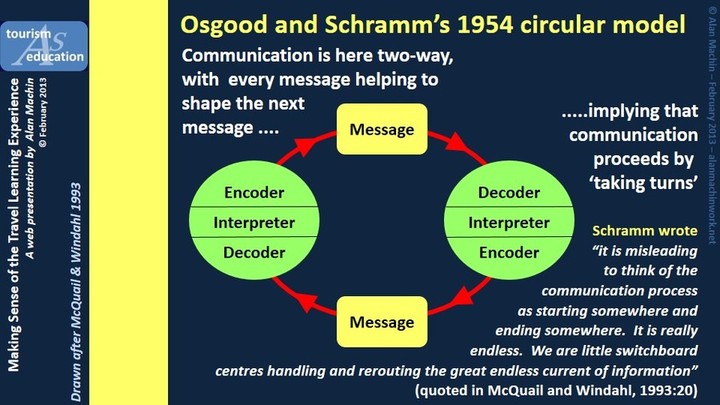
Charles Osgood (originator of the semantic differential research method in the 1950s) and Wilbur Schramm produced their circular model of communication. As with Shannon & Weaver and DeFleur it replaced linearity with circularity, but Schramm’s comment quoted above emphasises communication as swirling, “endless current of information”. His words carry an implication of it being a kind of high-speed engine of human communication.
The notable additions to the steps in communication in this model were encoding and decoding. The use of codes to handle political, military and commercial information was, of course, centuries old. Even publicly-known information could be turned into code for sake of brevity when handled by signalling systems. A ship about to set sail would fly the Blue Peter flag that anyone could recognise. Nelson’s famous ‘England Expects’ signal was encoded into a flag sequence. Nelson told his signal officer, Lieutenant John Pasco, to use the opening words ‘England confides’ but was reminded the second word needed spelling out, whereas ‘expects’ already had a simple flag code in the standard system used by the navy. The message was encoded by Pasco and flown. It travelled to the other ships through the simple channel of visible flags hoisted in a certain way. Officers in the ships of the fleet decoded it. The use of ‘expects’ may have sounded more like an admiral’s command. Nelson’s ‘confides’ would have given the impression of a commander confident that his men would do their duty because they were serving king and country, with no need to be ordered to do so. Decoding the flag sequence was one stage – understanding the nuances of the message was a matter of interpretation in the minds of those who received it. Nelson got his feedback through cheers, which broke out across the fleet. In other words, for those who were within earshot, it came through aural channels. Easy to decode and to interpret by anyone. Apparently, some ship’s officers recorded slight variations in their ship’s logs. Perhaps the noise and activity of battle acted as the communication noise, which led to the variations.
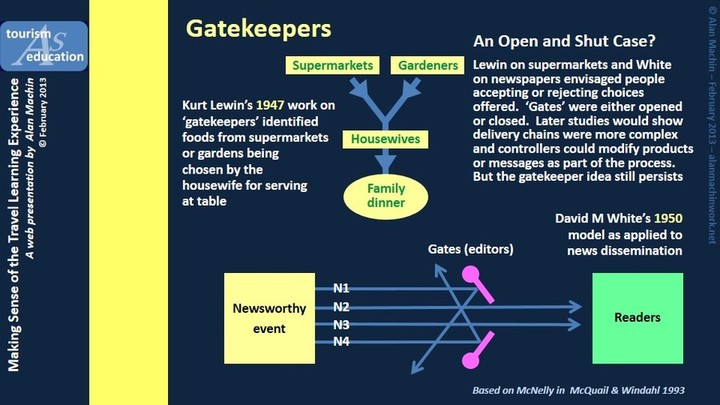
The German-American, Kurt Lewin, was a founding father of social psychology and exponent of the ‘gatekeeper’ concept. During the war, the popular meats – beef, pork chops and ham – were rationed with the best going to service men and women. He was asked to find out who were the main decision-makers in the meat supply chain so that those people might be persuaded to choose other products like beef hearts, sweetbreads, liver and kidneys. His findings used a model more complex than shown above, showing two main sources for the food consumed by families (the primary focus) as managers of supermarkets and home gardeners, followed by housewives, making up the chain who chose or rejected produce. These were termed gatekeepers by Lewin. In one of his research papers, he said that news stories also passed through a series of journalistic gatekeepers.
David Manning White carried out a detailed study of a wire editor, a man whose job it was to select stories arriving by agencies via electronic wire services. Stories were chosen for his newspaper according to the paper’s priorities, his views of what the readers liked to see, and his personal interests. White’s study appeared in 1950 with the simple schematic shown above. Seventeen years later, Paul Snider interviewed the same wire editor for another academic study and drew the same conclusions (Snider, 1967). David Berkowitz (1990) studied an Indianapolis TV station’s news handling. Stories were chosen according to those that were easiest to explain, attractive to viewers and easiest to edit. Gatekeeping was seen as a group process as stories passed through a chain of decision-makers (see Rogers, 1997:336-7, and the next slide, #16).
The gatekeeper theory is capable of application to tourist developments of every kind, and indeed, to the production and dissemination of human knowledge. At every stage along each of the flows of information in the four streams described early in this presentation there are gatekeepers. However, the open or shut analogy is insufficient, and I have doubts about the very word gatekeeper, which gives rise to that analogy. Most media theorists do state that messages are not only chosen or rejected, but can be modified by ‘gatekeepers’. Pamela Shoemaker and Tim Vos (2009) write: “the basic premise of gatekeeping scholarship is that messages are created from information about events that has passed through a series of gates and has been changed in the process”. So the word will remain in use here, at least for the moment.
The next section examines further application of gatekeeping to some elements of tourism.

John McNelly described the chain of reporters, bureaux chiefs and editors who handled news reports. He pointed out two weaknesses in the concept of gatekeeping. The first was that there was usually a whole sequence of ‘gatekeepers’, rather than just one, and second, it was not simply a matter of accepting or rejecting a product. In talking about news reporting, he had chosen a field with strong evidence that a product – this time, a news story – was likely to be modified in passing along the chain. A reporter on the scene of an event wrote a story that might be cut, or even lengthened with further information, by a news bureau editor. International, regional and local handlers of news reports might shape the story according to the interests of their newspapers and readers. At that time, over half a century ago, news was often passed from office to office using telephones or telegraph machines known collectively as ‘wire services’. These agencies, such as Reuters or Associated Press, would shape the same story according to the needs of different papers or broadcasters. McNelly also pointed out that each link-person in the chain fed back comments on stories to the one who supplied them. This feedback was an essential part of the process and affected the choice and styling of future stories.
McNelly’s principle of a chain of handlers modifying messages according to mutual interests and experience can be applied to tourist attractions. The example above shows a museum, but it would apply well to a theme park or a shopping centre with appropriate scaling up to reflect the complexities involved. Indeed, it could apply to tourist infrastructure – the design of a hotel, a transport system or even an internet booking system. In every case, ideas are formed, passed on and modified through a chain of stakeholders and contractors. In the museum example, an object is to be displayed. A curator will draft a description of its meaning and significance for the several audiences (experts, collectors, enthusiasts, students, the general public etc). The way in which it will be shown in a gallery with other objects will be determined. The interpretation (descriptive text, illustrations etc) will be arranged to satisfy the curators and experts while being understood by different kinds of visitors. It is a process that calls on the opinions, knowledge and experience of many different people in order to succeed.
But McNelly also highlighted something else, which is the subject of the next slide.
McNelly, John T (1959) Intermediary Communicators in the International Flow of News, Journalism Quarterly, vol 36, 23-6
See also McQuail, Denis and Windahl, Sven (1993) Communication Models for the Study of Mass Communications, Harlow, Addison Wesley Longman Ltd

McNelly showed that readers of newspapers passed on things they had read to other people. What they said depended not just on the paper’s story but their existing, personal, knowledge and viewpoint. Indeed, every reporter and editor could not do other than bring their own knowledge and attitude to bear in some degree, whatever their training and employment policy. At every stage, but especially at the end, in the form of the newspaper reader, the exact nature of the message received is shaped by matters of perception. We might use the word interpretation. How we interpret what we discover through our five senses depends on many external and internal factors.
In the first part of ‘Making Sense of the Travel Experience’, I indicated the part played by travel and tourism in helping us to discover our world. The attractions tourists visit have usually been shaped to greater or lesser degree by other people. Whether in a museum, theme park, rural or urban landscape, they have created messages, by definite intention or by chance, that visitors take in. Images and perceptions are created, reinforced or challenged in the complex, but influential, process of discovery represented by tourism – as education.
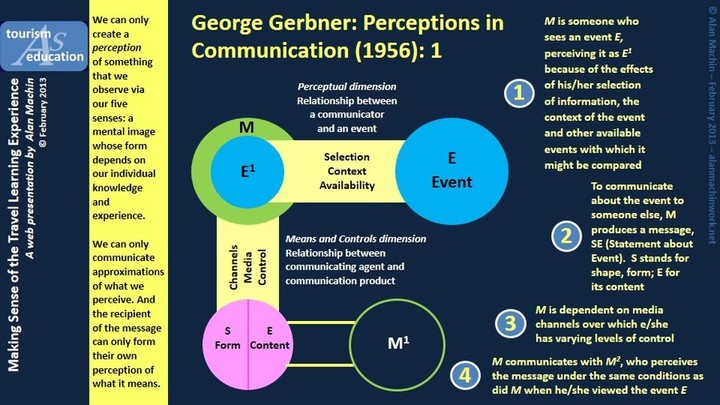
Like many researchers in communications, George Gerbner was an American, working in universities and interested especially in the effects of television viewing.
His work on perception in communication brought out the basic three-fold nature of the messaging process. ‘Perception’ is an idea with a very long history and a wide range of theoretical connections from the ancient Greeks to the modern world. In brief, Gerbner said that an event could be observed and information about it passed on to another person. As explained above, he said that the observer would have an understanding of the event, and that since human processes of perception were involved, this could not be the same as the event itself. Likewise, a message about the event communicated to someone else would be interpreted by that other person according to the circumstances and the experience of the second person.
George Gerbner’s ideas were influential in the understanding of how the media select, process and communicated information. They can also help anyone engaged in tourism to apply useful management principles to the kind of encounters tourists have with destinations and presentations about those destinations.

The graphic above attempts to represent the event-observation-communication-reception sequence active between a baseball spectator and another person.
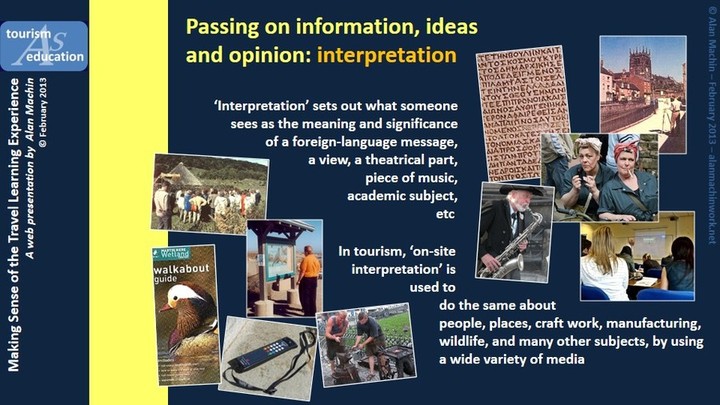
The word ‘interpretation’ can be confusing. We associate it mainly with the action of translating one language to another. Or with an actor interpreting a part or a musical performer interpreting a score. A painter might interpret a view in his or her personal style. A teacher interprets something in a lecture – in other words, explains to a class of students what it’s about. That happens to be me in the photo on the right, sneakily snapped on somebody’s mobile. Now I’m retired, it makes a nice memento.
Interpretation in tourism is very similar. It usually refers to the use of media on site to communicate the meaning and significance of what tourist are seeing (or hearing, touching, smelling, even, perhaps, tasting). Although the use of some of these media goes back centuries, it was in the mid-1950s that the American author on national Parks in the USA, Freeman Tilden, laid down the basic principles in his important book, detailed below. For a good general book, try the one by Grant Sharpe.
Beck, Larry & Cable, Ted (2002) Interpretation for the 21st Century: Fifteen Guiding Principles for Interpreting Nature and Culture, Champaign IL, Sagamore Publishing
Tilden, Freeman with Bomar, Mary and Craig, R Bruce (2008) Interpreting Our Heritage, Chapel Hill, University of North Carolina [extended version of the 1957 original work by Tilden]
Sharpe, Grant W (1982) Interpreting the Environment, New York & Toronto, John Wiley

Here is a collection of views of landscapes, from panoramas to close ups. Each photo was taken by me for one reason or another. You could say that I was the reporter observing a place, or an event, choosing to make a photographic message according to my motivations at the time.
But each piece of landscape was the outcome of the motivations and capabilities of many other people. Architects and city planners created the Chicago skyline to impress visitors. A Yorkshire farmer chose to farm his land with horses in the old-fashioned way. He wasn’t making a museum piece but a working farm that he loved. Belfast activists painted the murals as political statements with visitors as their audience. A medieval lord built Bodiam Castle as a statement of his authority and power, not just a practical piece of defence work. The two photos (top right) taken in Halifax were of a derelict building and a busy flyover. The viaduct was constructed as a solution to a tricky problem of handling traffic in a very confined urban space. Yet it also carries a message as well as a stream of vehicles. In the 1960s, it ‘spoke’ of progress, modernity, future prosperity. Today, the message may be different. It is a reminder that meaning and significance is in the eye of the beholder as well as the creator. And the way people interpret things they see, hear, and touch etc, changes with time.
Some landscapes are made in order to impress tourists. Others are made for other reasons. But whatever the nature of a place might be, visitors are going to read something into what they see, and that is why communities have to be aware of the need to manage their surroundings.
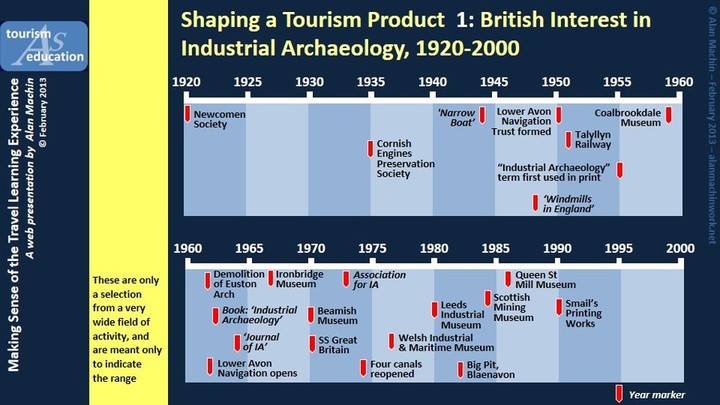
The complexity of activities that lead to new kinds of tourist attractions is illustrated by the case of industrial archaeology. This timeline shows some of the milestones in the rise of British interest. There were people interested in researching preserving examples of industrial machinery such as Newcomen steam engines, narrow gauge railways such as the Talyllyn or early steam ships such as the SS Great Britain. Books like Tom Rolt’s Narrow Boat or Kenneth Hudson’s Industrial Archaeology inspired readers. Journals were begun.
Museums were founded: at Coalbrookdale in Shropshire as a company showcase, in other places by charitable trusts engaged in conservation and education. English Heritage and the equivalents, Cadw in Wales, Historic Scotland and the Northern Ireland Environmental Agency, had their origins in government departments. Some of their work is in the field of industrial archaeology. So, too, is that of the National Trust for England and Wales, the National Trust for Scotland, and Ain Taisce, the equivalent body for Northern Ireland
Most ‘heritage tourism’ projects have been very much in the public, not-for-profit, arena. Numerous local government departments run museums and educational charities operate others locally.
Although they all have to cover their costs and might make an operating profit in order to do so, they plough their income back into their coffers in order to survive, and hopefully, to grow.
And they all have things to say, both to visitors and, through the media and education, to the world at large.

In 1959, Allied Ironfounders Ltd opened a small museum about its early history when it was known worldwide as the Coalbrookdale Company. The historian of Quaker enterprises, Arthur Raistrick, had researched and written about the ironmasters of the area. Many were prominent in the Quaker movement.
The government declared the area as a New Town in 1963, expanding it four years later under the name Telford. Local enthusiasts were worried that rapid development would obliterate many of the important industrial remains within its area. Telford Development Corporation, set up by the government to turn the existing towns and villages into a major new centre, joined with volunteers to form a charitable museum trust. The early plans were for an open-air museum like Beamish, which was being created in the same period of the late 1960s. All kinds of buildings, monuments and machines would have been moved to a new site.
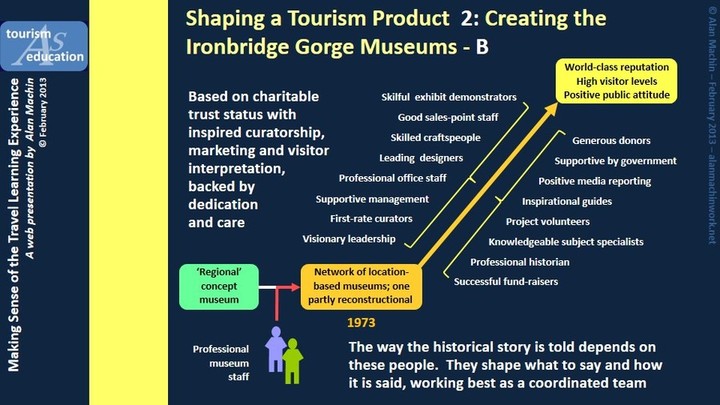
The plans for a ‘regional’ museum of the sort described in the previous notes were replaced when professional museum personnel were appointed.
The Ironbridge Gorge Museum Trust built a network of individual museum and preservation sites devoted to the industrial revolution. It used the controversial, but arguable, slogan that the world’s industrial revolution began in the area. Of course, it was a much more complex story involving many other places.
A combination of factors (suggested in the graphic above) turned the museum into an internationally important centre. It helped drive the regeneration of the valley as part of the strategy of the Telford Development Corporation, without whose money, staff secondments and organisational help, Ironbridge would have had a very different future. As a time-limited agency working on behalf of the government, the Corporation handed over its resources and activities to the Wrekin District Council in the early 1990s. The detailed account of the Corporation’s role in bringing about the museum and revitalising the Gorge can be easily overlooked.
Many individuals and organisations shaped the tourism product of Ironbridge. The meaning and significance of what happened there, and its role in the world’s industrial revolution, is therefore described in many different ways through the museum sites. It is a phase of history to be told and understood through much more than books and learned journals.
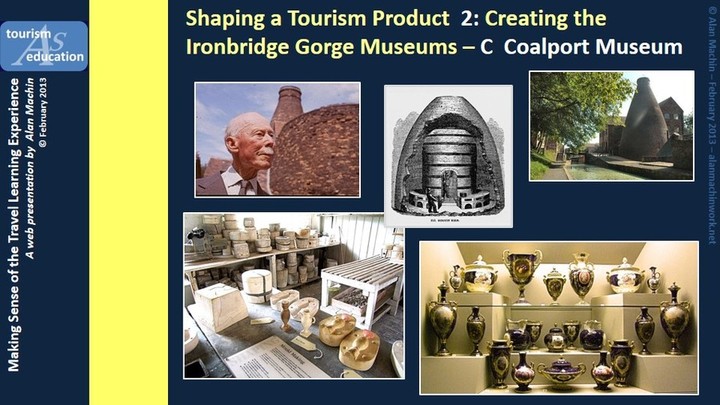
A former employee of the Coalport Company before the First World War, Bill Bagley, provided his knowledge of the pottery works during that time. Collectors and specialist researchers contributed items and more information that helped create the displays. Consultant designers from London worked with museum staff and the volunteer experts to set up the displays. The Coalport Museum opened in 1976. Exhibition galleries, guidebooks, audio-visual presentations, guided tours and craft demonstrations were used to narrate the history to between a quarter and a half million visitors who were soon exploring the several museum sites, including that at Coalport, seen here.

The next slides recap some of the ground covered in the ‘Back to Basics’ lecture given in Cuba (click to title in the list to the left).
The experience of a journey made is more than just the journey itself. Thinking about, and planning for, the journey begins to create knowledge about the places to be visited. And after getting back home, remembering what happened, finding out what other people thought of it, and doing some follow-up reading, will increase the store of knowledge even more.
That reflection process is aided by looking through photos and videos taken on the trip, reading any journal you might have written, and taking a fresh look at any souvenirs. It’s an interesting phase because it lasts as long as you can recall the trip you made: probably the rest of your lifetime.

Most people have some degree of awareness of a destination before there are thoughts of visiting it. Perhaps it’s a vague general knowledge of the region or the continent it’s in. There may be associations in the mind with the climate, type of landscape or the nature of the people. Opinions might be held about it that are positive or negative. This knowledge and those opinions will have been formed from other people, from previous travels of one kind or another; from the mass media and formal education received.
Once a specific interest has been aroused, thanks to a decision to make a visit, promotional media will be studied and personal research carried out. It’s a phase of active investigation. And if a family, group of friends or colleagues is going to join in on the journey, they will influence the ideas of the intending traveller.

The preparatory phase extends into the actual journey out. The traveller is committed. Much preparation has to be done right up until going out of the door and into the chosen transport. This can be a stressful phase. It colours the experience very quickly. Back in 1967, psychiatrists Thomas Holmes and Richard Rahe studied which life events had caused most stress to a sample of several thousand medical patients. The death of a spouse was rated top, at a hundred ‘units’. Committing a minor legal offence was rated 11, celebrating Christmas 12, and taking a vacation 13. ‘Taking a vacation’ appears on their list as having contributed to stress conditions. Going to a simple holiday destination came in at 13. What would a challenging trip abroad do to someone, especially if things went badly wrong? It is also noticeable that the period immediately before the time of departure can be very problematic, getting everything packed and the children ready and worrying about the transport arrangements working out. The subsequent levels of stress go up and down according to the stage of the trip and the events that it brings, all affecting the experience of the journey.
Managing that experience by the person making a visit is part of the key to successful travelling. Good service delivery by the many people looking after the traveller is essential all round.
The next slides provide an overview of just how many activities affect the travel experience. They all communicate feelings of satisfaction or dissatisfaction. All contribute to the cumulative opinion held by the traveller about the journey they have made.

There is a problem with discussions about what is known as environmental, heritage, or visitor interpretation.
Most of the practitioners and the books on the subject – some already mentioned – see it as happening solely at the destination. But as shown in this presentation, the information, ideas and opinions that arise from visiting a place can only be a part of a store of knowledge already built up over a long period.
Effective strategies to communicate ideas about the environment and human culture have to attempt to influence the complete sequence of preparation, visit and follow-up. That is a big thing to take on, but plenty of people do it successfully. They may be the bigger destinations and attractions, but even smaller ones could access services to help them.

A chat with engineering or planning departments in city or county council offices can help. There are legal and financial limits to what they can do and it can take a long time. On the other hand, they are there to help where they can. They can explain what can be done or not done. They might point out who else is worth approaching – in the UK, motoring organisations, for example, for event signposting. In the 1970s, in Britain, only urban destinations qualified for signposting. As the result of tourism being seen to be increasing in importance, there was a change in the regulations. The white-on-brown signs began to appear, pointing out attractions.
The laughter caused by the idea of that ‘secret’ nuclear bunker appearing on Essex road signs was a brilliant piece of verbal publicity!

What, trees that talk to you? Wildlife that says hello?
Well, yes. What is it that makes somewhere a nice place to be? Beautiful flowers and neat, green lawns. Clean-running rivers. Songbirds in the trees sat amongst waving branches… the blue sea crashing with white breaking waves on the beach….. OK, you can’t control the weather, switch on the bird song or arrange broad green leaves on winter oaks. But repairing, planting and keeping tidy the places used by visitors will give them a good impression and satisfy the residents.
Bird feeders can help. So can planting flowers that attract butterflies. I know of one place that persuaded a neighbouring farmer to keep some of his animals in fields close by. It was the closest some visitors had ever been to a flock of sheep. They loved it.
And those things are for the outdoors. Indoors, good hotels, stately homes, shops and the like know well the importance of attractive design, all of which ‘speaks to the customer’.
Interior décor is an important tool of communication!

Can tourism professionals ‘manage’ all of these people? No.
Can they influence how they deal with visitors? Yes, with difficulty and taking time to do it. And with variable results.
But destinations are judged by the results.

It’s a wide range of media to have available. Some are expensive, others cost little in terms of money, though may take time to perfect.
Choosing, planni.ng, designing and operating the right media are activities requiring expertise and flair.
The results make up the interface between destinations and visitors, together with those shown in the previous two slides.
Success depends on them.

The impact is huge.
The third and final part of this presentation, Making Sense of the Travel Learning Experience, will follow.
|

























